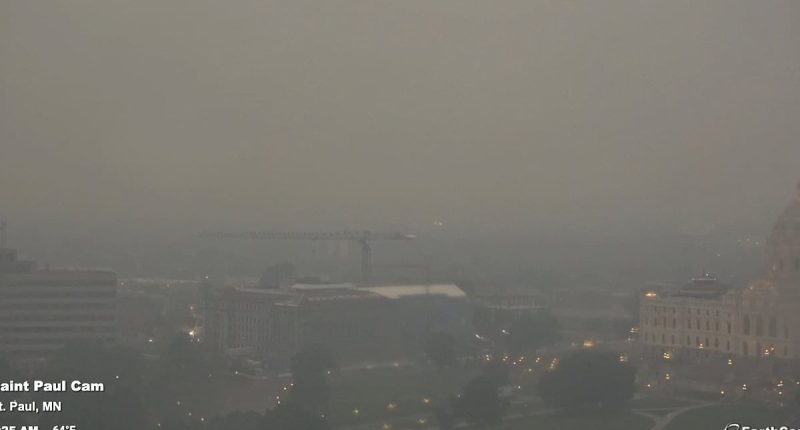Share this @internewscast.com

An air quality emergency has been issued in a Minnesota city, warning residents that any exposure could lead to serious health effects. Minneapolis and its suburbs are currently experiencing ‘Very Unhealthy’ air due to toxic wildfire smoke drifting in from Canada.

Several large wildfires have been burning across British Columbia, Saskatchewan, and Manitoba over the past week. Blaine, a suburb, currently has the worst air quality in the United States, followed by nearby Saint Paul, Minneapolis and Savage. More than 3.6 million Americans are under the alerts.

All of Minnesota is under some level of air quality alert, which officials say will remain in effect through midday Wednesday. Meteorologists warn that due to the size and scope of the Canadian wildfires, Minnesota is likely to face intermittent smoky skies for several more days. Smoke from over 160 active Canadian wildfires is also creating public health concerns in Wisconsin, Iowa and Nebraska.

These areas are experiencing conditions classified as from ‘Unhealth’ to ‘Unhealthy for Sensitive Groups,’ posing risks to pregnant women, children, the elderly, and those with respiratory conditions. The US Air Quality Index (AQI) considers a value of 50 or below to be ‘good’ air quality. But current readings in Blaine have reached 253, placing it deep in the ‘Very Unhealthy’ range. Saint Paul sits at 234, Minneapolis at 210, and Savage at 204, all of which are also hazardous to health.

These elevated levels are expected to persist through Tuesday afternoon, before gradually dropping into the 100s, a range still considered ‘Unhealthy for Sensitive Groups,’ through Wednesday. The official air quality forecast indicates that conditions are expected to improve to healthy levels by Thursday. Eastern Iowa, from Burlington to Maquoketa, is currently experiencing unhealthy air quality, according to the Iowa Department of Natural Resources.

Parts of northern and western Iowa are listed under a moderate air quality ranking. The region’s AQI is ranging from 151 to 200, while moderate levels sit from 51 to 100. Meteorologists said showers and thunderstorms are expected in the coming days that will push some of the smoke out of the area.

Brooke Hagenhoff, a National Weather Service meteorologist in Des Moines, told Des Moines Register : ‘With this incoming system, that’s going to help push a lot of the smoke off to the east, so with that we should start to see improvement as far as the haziness in the sky the past several days.’ The wildfire smokes is also concentrating in a small region of Nebraska around Blair and Blakely Township where levels are ‘Unhealth for Sensitive Groups.’ The Canadian province of Manitoba declared a state of emergency on Wednesday, triggering mass evacuations in the area.

Manitoba Premier Wab Kinew said: ‘This is the largest evacuation Manitoba will have seen in most people’s living memory.’ ‘The military is being called for help here because of the sheer scale of the 17,000 folks that we move relatively quickly.’ So far this year, Manitoba has had 102 fires, which officials say is ‘well above’ the province’s average of 77 by this time.

Separately, wildfires in Alberta province have prompted a temporary shutdown of some oil and gas production and forced residents of at least one small town to evacuate . That region was affected on Wednesday by wildfires spanning 11.2 square miles near Chipewyan Lake, a small community in the northern part of the province approximately 81 miles west of the oil sands hub of Fort McMurray.

Canada experienced its worst wildfire season on record in 2023, when more than 45 million acres were lost. Huge swaths of the US, from the north east to the Great Lakes, were blanked in smog for several days as a result. New York City Mayor Eric Adams urged millions of residents to remain indoors as a sheet of smoke from the wildfires left hose in Manhattan unable to see the New Jersey skyline across the Hudson River. Similar air quality alerts were also issued in Massachusetts, New Hampshire, Pennsylvania, Maryland, Illinois, Virginia and the Carolinas.








